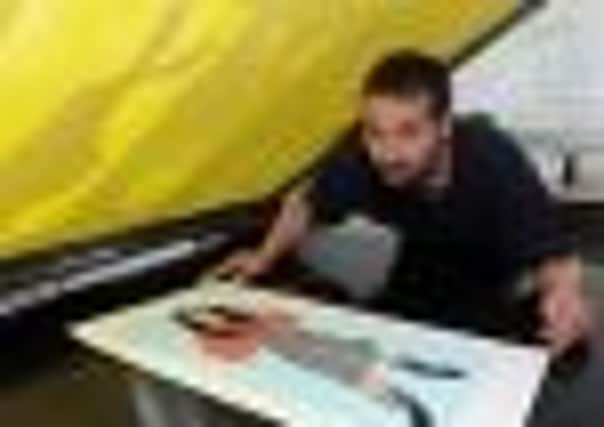Art review: The Writing On Your Wall, Edinburgh Printmakers


This is a show that celebrates the art and politics of printed matter, including popular prints, pamphlets, posters and political propaganda from 19th-century satire to last year’s general election. It features Turner Prize winner Jeremy Deller, venerable statesman Alasdair Gray and the young London-based Scot Ruth Ewan, who is currently turning heads with art that revisits forgotten struggles and radical histories in her major show Brank & Heckle at Dundee Contemporary Arts.
But first let’s be clear about the nature of the celebration: it’s a good old-fashioned wake. There are a lot of laughs, some tears, a bit of righteous indignation and an overwhelming sense that you are looking at print from a posthumous perspective.
Advertisement
Hide AdAdvertisement
Hide AdFrom an iconic Valentine typewriter, designed by Ettore Sottsass as the epitome of late 1960s mobility but now firmly pinned down in a glass case, to the comically typewritten and hand mimeographed catalogue that is so delightfully archaic and illegible it requires a word-processed sister publication, this is a show that is deeply ambivalent about the waning power of print.


Is print, like that beautiful typewriter, an elegant dinosaur? Is it, like the collection of important printed ephemera on show, a rare and valued treasure? Or is it, like the work of radical artists and agitators King Mob, whose story is central to the exhibition, a noble tradition of mischief, with a venerable history that includes heresy and revolution?
Back in 2003, when London-based curator and gallerist Rob Tuffnell worked at Dundee Contemporary Arts, he curated Ill Communication, a show that seemed on the face of it to celebrate all that was new and shiny about the digital age. Instead, it turned out to be a dystopian and slightly grumpy take on the subject, one which emphasised some of the more negative aspects of the internet age.
Invited to make a show for Edinburgh Printmakers, a gallery which often emphasises the rather attractive but intellectually less challenging end of the print market, Tuffnell has embraced old technology and old radicalisms with gusto. He draws together disparate eras of history including the Socialist Glasgow of Willie Gallacher; London in 1969, torn by anti-Vietnam protests and situationist agitation; and the Wapping dispute over print union practices with Rupert Murdoch in the Eighties.
Much in the show falls into the category of art – such as the prints of Alasdair Gray and the arch experiments of conceptual artists Art & Language. But it’s their conjunction with works that cross the boundaries that give them a real frisson, including the radical poster poems of Christopher Logue and the vintage posters from Wapping.
The latter communicate the agitprop politics of the period brilliantly: you have to hand it to the printers union SOGAT, they were as good as the Saatchis in their prime in creating the images of the era. There’s a smiling young Murdoch beside the words “The truth? He couldn’t give a XXXX” and the images of barbed wire fortress Wapping that have been echoed again and again in coverage of the phone hacking scandal.
Interestingly, from either side of the political fence, both Maurice Saatchi and trade unionist Brenda Dean ended up in the establishment as life peers.
Advertisement
Hide AdAdvertisement
Hide AdWapping seems suddenly vital again, as the newspaper industry must think through the implications of the internet age. Was this a dispute about intransigent unions thinking they could simply stare down irreversible technological trends? Or a parable about keeping an eye on those who harness technologies as much as technologies themselves? Are we conflating medium and message, or are they inextricably linked in what someone rather depressingly described to me last week as the Post-Gutenbergian age?
Print has an aura in the internet age that is undeniable. Artists are setting up impromptu newspapers, messing around with paper and ink as much as code. And they see no intrinsic conflict between tweeting and blogging and making the kind of stuff you can paste to lamp posts or hold in your hand.
When Ruth Ewan worked with pupils at Broughton High School, as part of this exhibition, they didn’t work on fancy computers, but devised a typeface by carving letters on plain old erasers. Ewan asked her collaborators to imagine the future and to write the headlines for a newspaper in 2030, turning them into screenprints. These are plaintive calls. My favourite is about as eloquent as it gets on the prospect of global warming, the words: “All ice cream have melted.” (sic)
What Tuffnell seems to suggest is interesting and counter-intuitive. For all that artists are often described as heralds of what is new; they are as interested in swimming against the tide as with it. What is obsolete, quaint and useless can become useful again, particularly in times of change or crisis. Thus the neglected histories and dwindling technologies of print may still have a lot to tell us. v
Until 29 October www.edinburgh-printmakers.co.uk